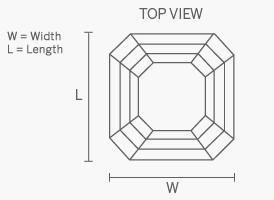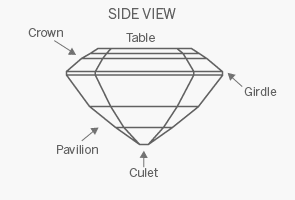Asscher Cut Diamond Shape
The Essential 7C's
Every diamond has its own story, and every lady her own style.
At this point it should be noted that the shape of a diamond can also be referred to as its “cut”, like a round or princess cut. However, this should not be confused with the more commonly used term of diamond cut, which describes how well the diamond has been polished from the raw material (see section on diamond cut).
At Seventy Seven Diamonds we cater to the detailed wishes of every customer and want to ensure that they are well-informed about every diamond shape available. Our selection of beautiful shapes is accompanied by detailed information, images and recommendations on the uniqueness, the history and background, and the ideal ratio of every cut.
Asscher Cut Diamonds
1. The Basics | 2. Features | 3. Expert Advice | 4. History
1. The Basics
Also referred to as: SQUARE EMERALD CUT

| Unique Features |
Facets |
L/W Ratio |
Origin |
Expert Tip |
| Brightest step cut, "hall of mirrors" effect. |
50 or 58 (Royal Asscher has 74) |
1.00 - 1.05 |
Art-deco era, early 20th Century |
Clarity VS1/VS2 and higher is optimal. |
2. Features



The Asscher cut is a unique shape with prismatic brilliance and a rectangular-faceted pavilion in the same style as the emerald cut.The standard number of main facets on an Asscher cut is usually 58 and the typical ratio for the more popular square-shaped Asscher cuts is 1.00 to 1.05.
The width of the cut corners may vary. With its deep pavilion, faceted culet, high crown and small table, the Asscher cut allows for tremendous lustre and creates a fascinating optical illusion known as the “Hall of Mirrors” effect.
The Asscher cut is referred to as a Square Emerald cut on a laboratory certificate, such as GIA or AGS. Although confusion reigns about what the differences are between an Asscher cut and a Square Emerald cut, they are in fact the same thing. However, there also exists a much rarer Royal Asscher cut, which is a patented version of the original Asscher cut with wide cut corners and 74 facets (instead of 58), and is classified as an octagonal step cut by the GIA.
3. Expert Advice
To fully appreciate the Asscher design, it is advisable to select a diamond of higher clarity (VS2 and above for GIA and VS1 and above for EGL, to ensure it is completely eye clean).
A table and depth percentage between 60 – 73.5% and 51 - 77% respectively is also recommended.
4. History & Background
Named after its creator Joseph Asscher, owner of the Amsterdam-based diamond company of the same name, the Asscher cut was developed in the early 20th century at the birth of the stylish and popular Art Deco movement. Joseph Asscher rose to fame several years later when he was commissioned by King Edward VII to cut the famous 3,106-carat Cullinan diamond for the English crown jewels. In 1980 Her Majesty Queen Juliana of Holland granted the Asscher Diamond Company a royal title in recognition of the role the Asscher family and company had held in the diamond industry. This cut’s popularity peaked in the late 1920s but remained a somewhat rare commodity for the remainder of the century, available only in antique shops and specialised Art Deco jewellers. At the onset of the new millennium, following considerable research and development, the Asscher cut was redesigned with new specifications and additional facets for a more brilliant shine, and has since regained its popularity.

Where next?
To view asscher cut diamonds offered by Seventy Seven Diamonds, please click here.
To customise your asscher cut engagement ring, please click here.
If you would like to read more about diamond education, please click here.